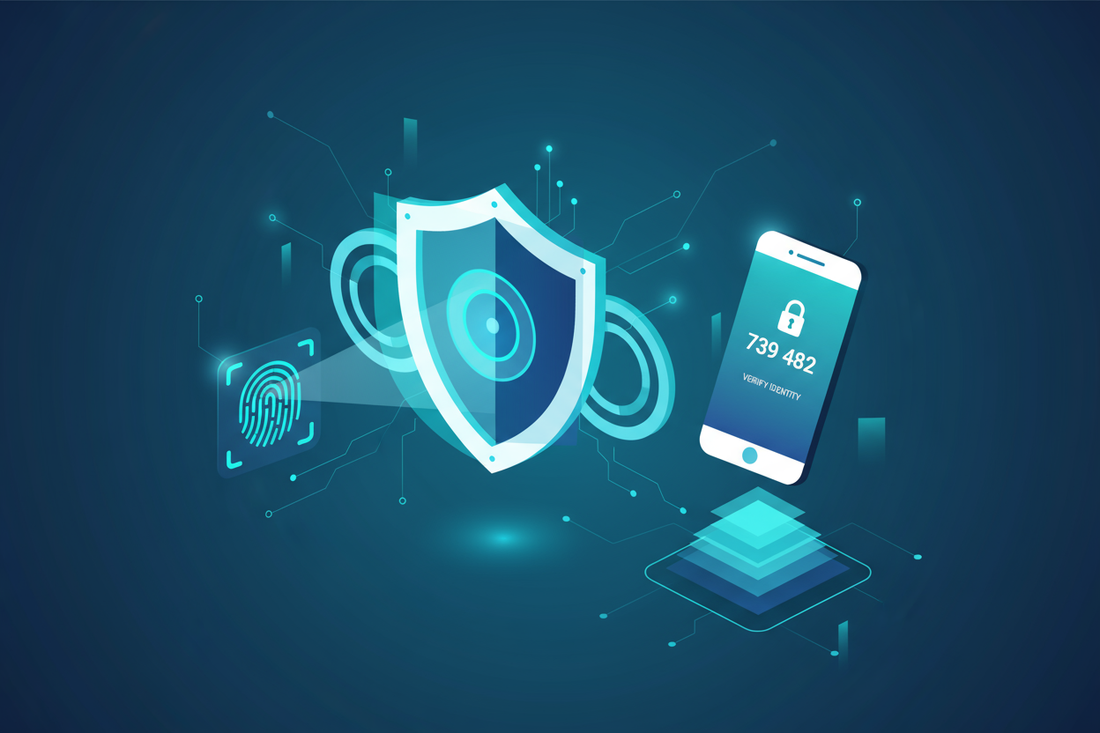
Understanding Multi-Factor Authentication and Two-Factor Authentication
Zane LucasShare
Digital security has evolved beyond simple password protection as cyber threats become increasingly sophisticated and data breaches more costly. Multi-Factor Authentication (MFA) and Two-Factor Authentication (2FA) represent critical security layers that protect sensitive accounts and systems from unauthorized access. These authentication methods have transitioned from optional security features to essential requirements for protecting business assets and customer data.
Organizations implementing SSL Certificates through Trustico® understand that comprehensive security requires multiple protective layers working together. While SSL Certificates encrypt data transmission between servers and browsers, authentication mechanisms ensure that only authorized users can access protected resources. The combination of encryption and strong authentication creates a robust security framework that addresses both data protection and access control.
Recent statistics reveal that compromised credentials remain the leading cause of data breaches, with over 80 percent of breaches involving stolen or weak passwords. MFA and 2FA dramatically reduce this risk by requiring additional verification beyond passwords, making unauthorized access exponentially more difficult even when passwords are compromised. This additional security layer has proven so effective that many regulatory frameworks now mandate its implementation for sensitive data access.
Understanding Multi-Factor Authentication and Two-Factor Authentication
Multi-Factor Authentication requires users to provide two or more verification factors to gain access to resources, combining something they know, something they have, and something they are. This layered approach ensures that compromising one factor alone cannot grant unauthorized access. Two-Factor Authentication represents a specific implementation of MFA that requires exactly two distinct verification factors.
The three primary authentication factors encompass different security elements that work together to verify user identity. Knowledge factors include passwords, PINs, and security questions that users memorize. Possession factors involve physical devices or digital assets like smartphones, hardware tokens, or smart cards that users carry. Inherence factors utilize biometric characteristics such as fingerprints, facial recognition, or voice patterns unique to each individual.
Modern authentication systems often combine these factors strategically to balance security strength with user convenience. For example, a typical 2FA implementation might combine a password (knowledge factor) with a time-based code from a smartphone app (possession factor). This combination provides robust security while remaining practical for everyday use across diverse user populations and technical environments.
The Critical Importance of Strong Authentication in Modern Security
Password-only authentication has become fundamentally inadequate for protecting valuable digital assets and sensitive information. Cybercriminals employ sophisticated techniques including phishing, credential stuffing, and brute force attacks that can compromise even complex passwords. The average person manages over 100 online accounts, leading to widespread password reuse that amplifies security risks across multiple platforms when any single account is breached.
Organizations face escalating threats from both external attackers and insider risks that traditional password security cannot adequately address. MFA and 2FA provide essential protection against these threats by ensuring that stolen credentials alone cannot compromise systems. This protection extends to scenarios where employees inadvertently expose credentials through phishing attacks or when former employees retain knowledge of system passwords.
Regulatory compliance increasingly demands strong authentication for accessing sensitive data and critical systems. Industries handling financial data, healthcare information, or personal customer details must implement MFA to meet standards like PCI DSS, HIPAA, and GDPR. Beyond compliance, strong authentication demonstrates commitment to security best practices that build customer trust and protect organizational reputation.
Implementation Methods for Two-Factor Authentication
SMS-based 2FA sends verification codes to users' mobile phones via text message, providing a widely accessible authentication method that requires no additional apps or hardware. While SMS authentication offers broad compatibility and ease of use, security experts increasingly recommend more secure alternatives due to vulnerabilities like SIM swapping and message interception. Organizations should consider SMS 2FA as a baseline improvement over passwords alone while planning migration to stronger authentication methods.
Authenticator applications like Google Authenticator, Microsoft Authenticator, and Authy generate time-based one-time passwords (TOTP) that provide stronger security than SMS codes. These apps work offline, eliminate SIM swapping risks, and support multiple accounts within a single application. The TOTP protocol ensures codes expire quickly, typically within 30 seconds, minimizing the window for potential exploitation.
Hardware security keys represent the gold standard for 2FA implementation, offering phishing-resistant authentication through physical devices that connect via USB, NFC, or Bluetooth. Standards like FIDO2 and WebAuthn enable passwordless authentication scenarios where hardware keys serve as primary authentication factors. While hardware keys require initial investment and user training, they provide unparalleled security for high-value accounts and administrative access.
Advanced Multi-Factor Authentication Strategies
Adaptive authentication dynamically adjusts security requirements based on risk factors such as login location, device recognition, and user behavior patterns. This intelligent approach applies stronger authentication when detecting unusual activity while maintaining convenience for routine access from trusted environments. For example, logging in from a recognized device at the usual office location might require only a password, while access from a new device in a foreign country triggers additional verification steps.
Biometric authentication has matured significantly with widespread adoption of fingerprint scanners, facial recognition systems, and voice verification technologies. Modern biometric systems incorporate liveness detection to prevent spoofing attempts using photos or recordings. The combination of biometrics with traditional factors creates particularly strong MFA implementations that balance security with user convenience.
Push notification authentication streamlines the user experience by sending approval requests directly to registered mobile devices, eliminating the need to manually enter codes. Users simply approve or deny access attempts through secure mobile applications, with cryptographic verification ensuring request authenticity. This method provides both security and usability benefits, particularly for frequent authentication scenarios in enterprise environments.
Enterprise Implementation Considerations
Successful MFA deployment in enterprise environments requires careful planning to balance security requirements with operational efficiency. Organizations must evaluate their existing infrastructure, identify critical systems requiring protection, and assess user populations' technical capabilities. Phased rollout strategies often prove most effective, starting with high-privilege accounts and critical systems before expanding to broader user populations.
User training and support represent crucial components of successful MFA implementation that organizations sometimes underestimate. Clear communication about security benefits, comprehensive training on authentication methods, and readily available support resources significantly improve adoption rates. Organizations should prepare for common challenges such as lost devices, backup authentication methods, and account recovery procedures that maintain security while minimizing productivity disruption.
Integration with existing identity management systems and applications requires technical consideration of authentication protocols and standards. SAML, OAuth, and OpenID Connect provide standardized frameworks for implementing MFA across diverse application portfolios. Organizations should prioritize solutions that support standard protocols to ensure broad compatibility and simplified management.
Addressing Common MFA Challenges and Concerns
Account recovery remains a critical consideration when implementing strong authentication, as users occasionally lose access to their authentication factors. Organizations must establish secure recovery procedures that verify user identity without creating backdoors that compromise security. Common approaches include backup codes stored securely offline, alternative authentication methods, and identity verification through trusted administrators or support personnel.
User resistance to additional authentication steps can hinder MFA adoption, particularly when implementation appears to complicate routine tasks. Addressing this challenge requires demonstrating clear security benefits, selecting user-friendly authentication methods, and potentially implementing adaptive authentication that minimizes friction for low-risk scenarios. Success stories and breach statistics can help users understand the importance of their participation in organizational security.
Cost considerations influence MFA implementation decisions, particularly for organizations with large user populations or limited budgets. While enterprise MFA solutions involve licensing costs, many effective options exist at various price points. Open-source TOTP solutions, free authenticator apps, and built-in platform features can provide strong security without significant financial investment.
Integration with SSL Certificates and Comprehensive Security
SSL Certificates from Trustico® protect data in transit between clients and servers, while MFA ensures that only authorized users can initiate those secure connections. This complementary relationship creates defense in depth, where multiple security layers work together to protect against various attack vectors. Organizations implementing both technologies demonstrate comprehensive security commitment that addresses authentication, authorization, and encryption requirements.
SSL Certificate-based authentication represents an advanced integration of SSL Certificate technology with MFA principles, where Digital Certificates serve as authentication factors. Client Certificates installed on user devices provide cryptographically strong authentication that combines with passwords or other factors for robust MFA implementation. This approach particularly suits high-security environments where traditional authentication methods prove insufficient.
The combination of Extended Validation (EV) SSL Certificates with strong authentication creates particularly powerful trust signals for users. When visitors see the verified organization name from an EV SSL Certificate and experience secure authentication processes, confidence in the platform's security commitment increases substantially. This trust building translates directly into improved user engagement and business outcomes.
Future Trends in Authentication Technology
Passwordless authentication represents the next evolution in security technology, where MFA factors replace passwords entirely rather than supplementing them. Technologies like FIDO2 passkeys enable users to authenticate using biometrics or hardware keys without traditional passwords, eliminating password-related vulnerabilities while improving user experience. Major technology platforms increasingly support passwordless options, signaling a fundamental shift in authentication paradigms.
Behavioral biometrics analyze patterns in user behavior such as typing rhythm, mouse movements, and device handling to create unique authentication profiles. These passive authentication methods operate continuously in the background, detecting anomalies that might indicate unauthorized access without requiring explicit user action. The combination of behavioral biometrics with traditional MFA creates particularly sophisticated security systems.
Decentralized identity and blockchain-based authentication systems promise to give users greater control over their digital identities while maintaining strong security. These emerging technologies could enable portable authentication credentials that work across multiple platforms without centralized password databases that attract attackers. While still evolving, decentralized authentication may fundamentally reshape how organizations approach identity verification and access control.
Best Practices for MFA Implementation
Risk-based implementation prioritizes MFA deployment for high-value targets including administrative accounts, financial systems, and databases containing sensitive information. This focused approach maximizes security improvements while managing implementation complexity and costs. Organizations should conduct thorough risk assessments to identify critical assets and determine appropriate authentication strength for different access scenarios.
Regular security awareness training ensures users understand both the importance of MFA and proper usage of authentication tools. Training should cover recognizing phishing attempts that try to capture authentication codes, protecting authentication devices, and following proper procedures for reporting security concerns. Ongoing education helps maintain security vigilance as threats evolve and new authentication methods emerge.
Monitoring and auditing MFA usage provides insights into authentication patterns, potential security incidents, and areas requiring additional attention. Organizations should track metrics including adoption rates, authentication failures, and recovery request frequency to optimize their MFA implementation. Regular reviews of authentication logs can reveal attempted breaches and guide security improvements.
Industry-Specific MFA Requirements and Applications
Financial services face stringent regulatory requirements for strong authentication, with standards like PSD2 in Europe mandating Strong Customer Authentication (SCA) for electronic payments. Banks and payment processors must implement MFA that meets specific technical standards while maintaining transaction efficiency. The challenge involves balancing regulatory compliance, security effectiveness, and customer experience in high-volume transaction environments.
Healthcare organizations must protect patient data under regulations like HIPAA while ensuring medical professionals can quickly access critical information during emergencies. MFA implementations in healthcare often incorporate proximity badges, biometric scanners, and mobile authentication to provide secure yet rapid access. Special consideration for emergency override procedures ensures patient care never suffers due to authentication requirements.
Educational institutions face unique challenges implementing MFA across diverse user populations including students, faculty, staff, and parents with varying technical sophistication. Successful education sector deployments often emphasize user-friendly authentication methods and comprehensive support resources. Integration with learning management systems and student information platforms requires careful attention to maintain seamless educational experiences.
Implementing MFA with Trustico® Security Solutions
Organizations securing their infrastructure with Trustico® SSL Certificates can enhance protection by implementing comprehensive MFA strategies across their systems. The combination of encrypted communications through SSL Certificates and strong authentication through MFA creates robust security architecture that addresses modern threat landscapes. This layered approach demonstrates security maturity that builds stakeholder confidence and supports business growth.
Technical teams can leverage Trustico® expertise in Digital Certificates to implement SSL Certificate-based authentication as part of their MFA strategy. Client Certificates provide cryptographically strong authentication factors that integrate seamlessly with existing SSL Certificate infrastructure. This approach particularly benefits organizations already familiar with SSL Certificate management through their Trustico® SSL Certificate deployments.
The journey toward comprehensive security requires ongoing commitment to implementing and maintaining strong authentication alongside encryption technologies. Organizations that combine Trustico® SSL Certificates with robust MFA implementation position themselves at the forefront of security best practices. As cyber threats continue evolving, the combination of strong authentication and encryption will remain fundamental to protecting digital assets and maintaining user trust in an increasingly connected world.



